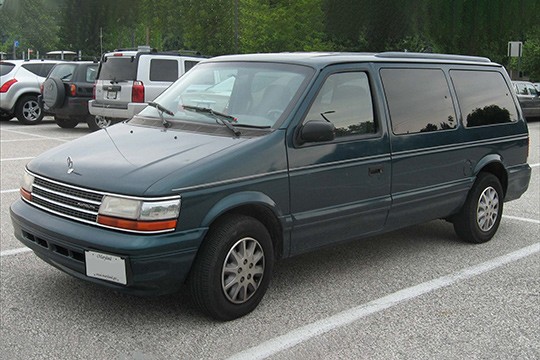PLYMOUTH VOYAGER Models/Series Timeline, Specifications & Photos
First production year: 1984
Engines: Gasoline
Body style: Van
The Voyager saga continued in 1995 with the introduction of the third generation, and the Plymouth was again the entry-level model for Chrysler's minivans.
Plymouth sold the third generation of the Voyager in two-wheelbase options for the Voyager and the Grand Voyager, respectively. Unlike its predecessors, which shared the same platform, the 1995 model was completely changed from tip to toe. The minivan was no longer a box on wheels but shaped according to the bio-design trend that was liked by customers. In addition, there were major improvements to the interior.
The 1995 Voyager showed a front fascia that sported rounded horizontal headlights with corner-mounted turn signals. The grille featured an egg-crate design with the brand's logo in the middle. One of the major improvements of this generation was the addition of a second sliding door on the driver's side, offered as an option. The long-wheelbase version featured an extended rear window behind the B-pillars. Finally, the back didn't look like a utility van anymore since the designers made it curved.
Inside, the MPV featured a car-like dashboard with rounded shapes. The seats were higher than in a regular sedan, but they ensured a comfortable ride. In the back, the Voyager was available with two rows of seats. Since it was built as a lower-priced model, it wasn't available with standard AC until 1999, when this was introduced on the SE trim level and up. The interior room was big enough to carry a 4x8 (1.2 x 2.4 m) plywood with the second and third bench seat rows removed. Also, the interior features list was long and comprised comfort and safety features.
Like its siblings, the Voyager was available with a choice of four engines, depending on the market. They ranged between 2.4 and 3.8-liter displacement. The latter was discontinued in 1999. In 2000 the model was axed altogether with the Plymouth brand.
Plymouth introduced the second generation of the Voyager in 1990 for the 1991 model-year and built it on the same platform as its predecessor, albeit enhanced.
During the late '80s, minivans ran the high tides thanks to their ability to carry people, perform duties suitable for a light commercial vehicle, and save money for renting a U-haul van when taking kids to college. Nevertheless, these people-movers could get three families of two and some luggage aboard. Their practicality was so good that they could withstand the assault of the rising SUV segment.
When it made its minivans family, the American automaker stretched and adapted the K-platform used on the LeBaron/Acclaim/Spirit cars. As expected, the Plymouth version was positioned between the more luxurious Chrysler and the sporty Dodge. Even though it was a badge-engineered product, it still sported some brand-specific details, such as the horizontal slats on the grille and the rectangular headlights. Unlike its predecessor, it featured shaved edges and corners, trying to look more appealing to those looking for rounded shapes.
Inside, the automaker offered a wide cabin with two seats at the front and up to six on the following two rows of seats. For the entry-level, the Voyager featured a floor-mounted gear stick, but the more upscale versions were fitted with automatic gearboxes. Still, there was enough room for front occupants to move around and pass through the cabin if needed. On the middle row, Plymouth installed either a set of captain seats or a bench with one folding chair to ease access to the rearmost row of seats.
Since it shared its platform with the Acclaim, the base version was powered by the same 2.5-liter inline-four. At the other end of the scale, Plymouth installed a 3.3-liter V6 paired with a four-speed automatic. Starting with the 1994 model-year, the automaker replaced this powerplant with a more powerful 3.8-liter mill.
Chrysler introduced its minivans lineup in 1984 as an alternative to family minivans, and the Plymouth Voyager was among the first to arrive on the market.
While regular vans didn't fit in regular garages, Chrysler came up with a better idea when it made the T-wagons. With their height shorter than a person and a footprint about the size of a regular compact station wagon, these MPVs conquered the market.
With its boxy look, the Voyager has fitted into the car's design trend from the mid-80s. Its front fascia featured a pair of rectangular headlights on each side of the vehicle and a broad flat grille between them that sported chromed horizontal slats. The chromed bumper with plastic caps on each end looked normal for those days. On the passenger side, the Voyager was fitted with a front-hinged door at the front and a sliding one in the middle for the rest of the cabin's occupants. The back of the minivan was fitted with a large tailgate that opened upwards.
But the interior was the one that mattered most. Since the Voyager was built on a unibody platform that featured a front-wheel drive system, the floor's height was low. Thus, passengers could get in and out more easily than on regular, body-on-frame-based vans. At the front, the stylish but boxy-looking dashboard followed the car's overall shape, and two bucket seats were provided for the front occupants. The middle row was suitable for two adults, while the rearmost row could accommodate three people. In the five-seat configuration, the middle row was redesigned for three passengers. The owners could fold or remove all the seats apart from the front ones to create a vast interior.
Plymouth installed a few engine options for the Voyager, starting with a 2.2-liter inline-four paired with a five-speed manual or a three-speed automatic. Still, for those willing to hear a six-cylinder mill under the hood, the automaker offered a 3.0-liter V6 carried over from Mitsubishi.


